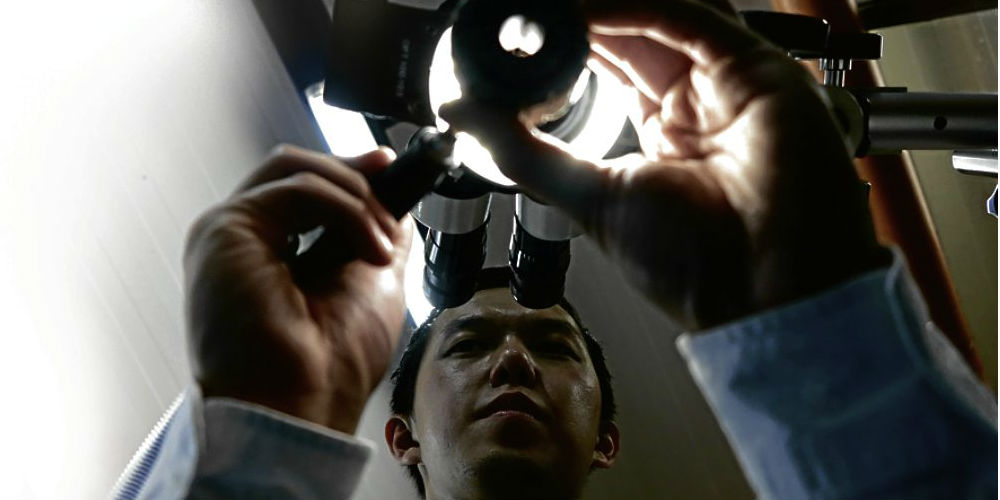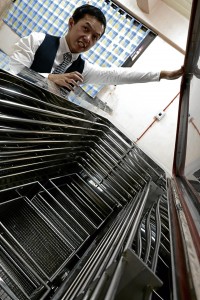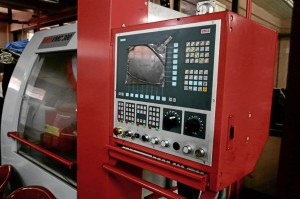Aerospace technology center rises in Baguio

JERRISON Tiong demonstrates a deburring operation using a pen grinder aided with microscope lighting and fiber optic light.
BAGUIO CITY, Philippines—Jerrison Tiong is still in his 20s, but he recast himself from a licensed mechanical engineer in 2008 into the president and “value stream manager” of the start-up firm that will soon provide the needs of Moog Controls (Philippines), a manufacturer of aircraft parts at the Baguio City Economic Zone.
Tiong convinced businessmen to invest P12 million in his firm, Aurochs Aerospace Precision Manufacturing Co. Since July, he has been monitoring future employees, who undergo training courses in precision machining and bench work that would hone their skills in shaping electronic and manual actuator components, according to international quality standards.
Moog’s Philippine division produces actuators, which control airplane wing rudders, for most American and European aircraft manufacturers, said Edward Frenzel Yapyapan, a Cordillera trustee of the Metalworking Industries Association of the Philippines (MIAP).
Expansion plans
Recently, the firm had determined that tapping a local supply chain would improve its overhead costs and render obsolete the company’s expensive expansion plans, Yapyapan said.
Moog’s future supply deals with Tiong is, for all intents and purposes, an example of outsourcing, he said.
But it is the kind that taps a homegrown supply chain, which Tiong and many metals industry advocates see as rising at Baguio’s idle Loakan Airport near the zone.
Commercial flights have not been operating from the city’s historic airport for years now, thus making it a potential expansion area for the BCEZ.
But in the near future, the Loakan Airport could serve as the hub of an aerospace technological park, composed of private machinist companies and service contractors that would build parts required by Moog and other airline manufacturing suppliers.
A Baguio aerospace techopark fulfills the final stages of Project CREAMM, which stands for “Clustering of the Regional Enterprises of CAR (Cordillera Administrative Region) for Agro-Industrial Machinery and Parts Manufacturing.”
In a paper by research group, Cordillera Industry and Energy Research and Development Consortium (CIERDEC), CREAMM was designed as an industry down-streaming program by the Cordillera Regional Development Council “to improve the productivity and competitiveness of the metals and engineering micro, small and medium enterprises in the region by organizing them into clusters and raising their competency level [in order to] enable them to cater to the equipment and parts requirements of the Moog Controls Corp.”
Tesda programs
Yapyapan said constructing metal parts for airplanes is no different from manufacturing bolts for an automobile, so training programs designed and offered by the Technical Education and Skills Development Authority (Tesda) for future Moog suppliers and contractors will bridge only minor gaps in techniques and the science.
He said that what Moog requires from its homegrown suppliers are efficiency and the machinist’s dedication to keeping within world quality standards.
Baguio’s new role as a potential center for aerospace machinists is also timely, Yapyapan said, because the city churns out hundreds of university graduates each year which Moog and other aircraft manufacturing firms could tap for manpower or service contract needs.
Arthur Lucas Cruz, executive director of the government’s Metals Industry Research and Development Center (MIRDC), said aerospace technology is the next sunshine industry that should draw the interest of local businessmen.
Manufacturing programs

DEGREASING machine removes oil and grease that accumulate during the machining process. PHOTOS BY EV ESPIRITU/INQUIRER NORTHERN LUZON
He said Asian countries like China have launched their own airplane manufacturing programs and will soon require parts suppliers which a Baguio aerospace park can provide.
The metals providers of this future park can also augment the needs of other future industries, Cruz said, citing a proposed e-train project to link the Subic and Clark economic zones with Metro Manila, and a project that aims to design a new fast-charging battery.
He said the potentials of aviation are not even considered by government planners, who have allocated more funds for an automotive industry buildup.
The private sector should be interested in building the Baguio aerospace techopark, and it should start with Tiong, Cruz said.
Tiong added: “If you note the global demand for commercial aircraft, almost 24 percent of the backlog from 2010 to 2030 are from the Asia-Pacific region [and] 14 percent is from China. So [the demand amounts to] almost 40 percent in our neighborhood. What propelled Asia-Pacific demand for aircraft is the growth of tourism and low cost carriers.”
“We have had Moog [at the Baguio economic zone for decades] and its been a major player in the aerospace industry. It is looking for suppliers and that demand gave MIRDC the initiative to tap small enterprises to supply Moog. The market is huge. The potential is huge. And Baguio is the best place [to exploit this],” he said.
